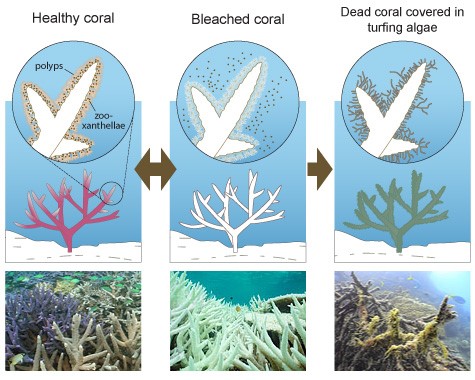Displaying items by tag: Great Barrier Reef
New hope for the environment following the election
At last we have some good news to report. The country is breathing a sigh of relief following the defeat of the Morrison government, even expressing whoops of joy.
The major areas relating to the environment where we are hoping for big new effective policy change are outline below.
Energy
The new Albanese government has been thrown in the deep end with a crisis in energy supply. Gas and petrol prices have soared because of the war in Ukraine. Electricity has been in short supply because of the failure of several coal-fired power stations, the need to use expensive gas and the rise in demand in response to the cold snap. All these factors highlight the abysmal management and policies of the Morrison government.
At last we will see some real action with rapid expansion of the transmission grid to facilitate the use of renewable energy and more support for these projects. There is more positive action proposed to support the transition to use of electric vehicles. These actions will take time to be effective but 2030 is not far away!
The emissions reduction target will be improved to a 43% reduction below 2005 levels by 2030. This is still viewed as inadequate by the Climate Council and the ‘teal’ candidates. Labor is still not strong enough on closing down coal mines and stopping new projects.
A review will be held of Australia’s controversial carbon offset programs, to be conducted independently of government departments and agencies. This is vital for the effectiveness of plans to reach net zero emissions – see the previous STEP Matters.
Land clearing
Labor has promised to set a domestic target to protect 30% of land and 30% of sea areas by 2030.
Great Barrier Reef
Labor has promised to increase funding to tackle agricultural pollution, more sustainable fishing practices and research into thermal tolerant corals. But the really meaningful solution is rapid reduction in carbon emissions
Murray–Darling Basin
After years of the Nationals favouring big irrigators and undermining the Murray– Darling Basin Plan, the new government has a chance to restore more natural flows to the rivers of the Murray–Darling Basin, establish integrity and transparency for water management, and get the plan to revive our rivers back on track.
The review of the Murray–Darling Basin Plan will occur during this term of parliament, so there is the possibility of increasing water recovery targets towards what the science says is necessary for healthy rivers, wetlands and floodplains.
Biodiversity
The previous environment minister, Sussan Ley, refused to release the State of the Environment Report that was finalised last December. The new Minister for Environment and Water, Tanya Plibersek has indicated that it tells an ‘alarming story’ of decline, native species extinction and cultural heritage loss. She will release the report in a speech to the National Press Club on 19 July.
Labor has promised to create a federal Environmental Protection Agency to improve environmental compliance, information and analysis. We hope this agency will be genuinely independent and have real teeth.
Furthermore, there’s been a failure to address one of the most egregious failings of our system which is to evaluate cumulative impacts of projects on the environment as opposed to a license by license approach.
Great Barrier Reef in Peril but Adani Mine Approved
At the end of March aerial surveys of more than 500 coral reefs from Cairns to Papua New Guinea revealed that the most pristine sections of the Great Barrier Reef are currently experiencing the worst, mass bleaching event in its history, with the overwhelming majority of reefs (95% has been quoted) being ranked in the most severe bleaching category.
Bleaching is caused by abnormally warm sea temperatures that have been boosted by the El Niño event that commenced in mid-2015 leading to sea surface temperatures more than 1°C above normal. These conditions are predicted to occur more frequently and more severely as greenhouse gas concentrations in the atmosphere increase.
As ocean temperatures have not cooled down yet in the northern section it is too early to tell what the long-term implications of this event will be. This depends on how soon ocean temperatures reduce and the time before another event occurs. Reefs need about ten years to recover.
The Great Barrier Reef has experienced mass coral bleaching events in the past. In 1998, there was a global mass bleaching event where 50% of the reefs on the Great Barrier Reef were affected. During this time, sea temperatures on the Great Barrier Reef were the highest ever recorded. Mass bleaching also occurred in 2002, with 60% of reefs were affected. This was the largest coral bleaching event on record.
In both the 1998 and 2002 events, the vast majority of corals on the reef survived, as sea temperatures came back down again in time for them to recover. About 5% of the Great Barrier Reef’s coral reefs experienced coral die-off in both these events.
 What is Coral Bleaching?
What is Coral Bleaching?
From www.globalcoralbleaching.org
Many types of coral have a special symbiotic relationship with a tiny marine algae (zooxanthellae) that live inside corals’ tissue and are very efficient food producers that provide up to 90% of the energy corals require to grow and reproduce.
Coral bleaching occurs when the relationship between the coral host and zooxanthellae, which give coral much of their colour, breaks down. Without the zooxanthellae, the tissue of the coral animal appears transparent and the coral’s bright white skeleton is revealed. Corals begin to starve once they bleach. While some corals are able to feed themselves, most corals struggle to survive without their zooxanthellae.
If conditions return to normal, corals can regain their zooxanthellae, return to their normal colour and survive. However, this stress is likely to cause decreased coral growth and reproduction, and increased susceptibility to disease. Bleached corals often die if the stress persists. Coral reefs that have high rates of coral death following bleaching can take many years or decades to recover.
Global Coral Bleaching
In 1998, a huge underwater heatwave killed 16% of the corals on reefs around the world. Triggered by the El Niño of that year, it was declared the first major global coral bleaching event. The second global bleaching event that struck was triggered by the El Niño of 2010. The US National Oceanic and Atmospheric Administration announced the third global bleaching event in October 2015 and it has already become the longest event recorded.
The new phenomenon of global coral bleaching events is caused by ocean warming (93% of climate change heat is absorbed by the ocean). Corals are unable to cope with today’s prolonged peaks in temperatures – they simply haven’t been able to adapt to the higher base temperatures of the ocean. Although reefs represent less than 0.1% of the world’s ocean floor, they help support approximately 25% of all marine species. As a result, the livelihoods of 500 million people and income worth over $30 billion are at stake.
What can be done?
A major global bleaching event is considered one of the most visual indicators of climate change. Clearly the current experience demonstrates the importance of taking action to reduce greenhouse emissions. Apart from the potential loss of thousands of jobs in the tourism sector future generations could miss out on experiencing this environmental masterpiece. In the face of this situation the announcement on 3 April by the Queensland Government of the go ahead for the development of the largest coal mine in Australia is hard to fathom.
Adani’s own figures are that the mine and the burning of the mined coal will emit more than 4,600 Mt CO2 over its 90 year lifetime. The Australia Institute has estimated that average annual CO2 emissions will be 79 Mt. Australia’s current annual emissions are around 600 Mt. Many conditions have been placed on the mine and port operation aimed at limiting direct environmental damage but nothing can be done to stop the long-term damage from burning the coal.
There is still some legal action being taken by the local Aboriginal land owners and the Australian Conservation Foundation is taking action based on Australia’s commitments under the world heritage convention, which dictates Australia ‘do all it can to the utmost of its resources to identify, conserve, present and transmit to future generations the outstanding universal value of the Great Barrier Reef world heritage area’ – and that this must be the primary purpose of management of the area.
It says Environment Minister Greg Hunt ‘made an error of law’ by characterising emissions from transport by rail, shipping and then the burning of the Adani coal overseas as ‘not a direct consequence of the proposed action’.
The other hope for stopping the mine is that the falling price of coal will risk the financial viability of the coalmine so that bank finance will be unavailable. Dredging of the port at Abbot Point cannot commence until finance is secured.

